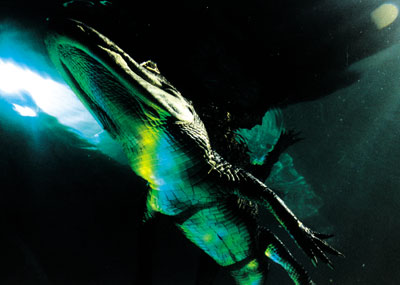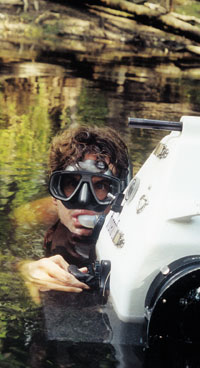LATER, ALLIGATOR
By Reed Martin
 |
| Photo by Tim Calver. |
MANNING THE CRAFT-SERVICE TABLE is one thing, but ending up as part of the menu is a situation most low-budget filmmakers never have to face. For 35-year-old director and cinematographer Pete Zuccarini, it’s always a distinct possibility.
As founder of Coconut Grove, Fla.—based Waterfilm, Inc., Zuccarini and his wife/associate producer/sound engineer Susan Short regularly risk becoming lunch for their lead actors on the alligator and shark documentaries they shoot all over Florida and the Caribbean. "Sometimes you’re trying to make a decision about whether or not to lose the equipment before your life is in danger," says Zuccarini, who shoots in numerous formats, from 35mm down to mini DV. "Once you’re in trouble, you forget about the cost – whatever you’re using becomes the nearest solid object you have to defend yourself. If you’re about to be eaten, a tripod can be used as a spear, and the camera makes a good hammer."
Most of the docs Zuccarini is hired to shoot are financed in the $200,000-to-$400,000 range by U.S. cable outlets or European television networks. Waterfilm’s first self-produced ’gator documentary, Everglades: Home of the Living Dinosaurs, which was picked up by Disney last year for TV distribution, required the couple’s commitment for 160 grueling shooting days over two years. Short and Zuccarini braved mosquito squadrons, ridiculous humidity, wet clothes, no bathrooms, laughing fits and stifling boredom.
"We once had to wait from dawn to dusk for 10 days to film a mother alligator delivering her babies," Zuccarini recalls. "Another time we spent three days with the camera on a floating dead alligator, waiting for the vultures to come." Adds Short, 32, with a laugh, "It was so incredibly hot even at night that it became like a toughness contest. I kept saying to myself, ‘I’m not giving in! I’m not giving in!’ We were both as tenacious as bulldogs, but I’m sure if it had been only one of us out there, we would have come to our senses a lot sooner."
 |
| Director Pete Zuccarini with Hydroflex Housing. |
Zuccarini is now regularly asked by producers to "get a little closer," but he refuses to behave recklessly when in the water with 400- to 600-pound predators. "The moment you feel the animal actually stalking you is when you’re being told ‘Okay, you’ve crossed the line,’" he says. "There are signs to clue you in that a situation is developing, but they’re very subtle, so you have to pay attention." Zuccarini tries not to miss these tiny moments, because they are also his cue to roll camera. "If you push the button a second too late, the shot will be worthless because the audience won’t be able to tell what the action was," he says.
Learning about animal body language from local biologists, wildlife officers and the creatures themselves is certainly the key to staying out of the emergency room. "An alligator will go from a head floating on the water to its full length visible on the surface by inflating lungs in its back,"Zuccarini explains. "But a filmmaker who doesn’t realize that this is a threatening posture might say, ‘This is a great shot!’ and keep moving in for a close-up. Unfortunately, they might end up with teeth across the back of their head!"
In between paid gigs, Zuccarini and Short produce their own nature programs on spec. Their most recent self-financed venture is a study of Caribbean iguanas that drift from island to island on storm-tossed trees. But the public’s fascination with aquatic predators is what ensures Zuccarini and his cameras steady work. Every time Zuccarini tries to get out, the sharks and alligators pull him back in – at least metaphorically.
VOD CALENDAR


 See the VOD Calendar →
See the VOD Calendar →


